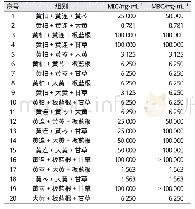《Table 2 MIC and MBC results of CMC-g-EPL copolymers》
 提示:宽带有限、当前游客访问压缩模式
提示:宽带有限、当前游客访问压缩模式
本系列图表出处文件名:随高清版一同展现
《ε-Poly(L-lysine)-based Hydrogels with Fast-acting and Prolonged Antibacterial Activities》
a MIC is the lowest concentration of the copolymer where the solution is clear.It is obtained according to the results in Table S2(in ESI);b MBC is the lowest concentration where there is no bacterial colony on the plate.The EPL grafting degrees of copol
To evaluate the antibacterial activities of the precursors of hydrogels,MIC of CMC-g-EPL copolymer was tested,which is defined as the lowest concentration of the antimicrobial agent that inhibits visible growth of the tested isolate in 16–20 h,as observed with the unaided eye according to the Clinical&Laboratory Standards Institute(CLSI)and previous protocols[23].The aqueous solutions of the CMC-g-EPL copolymers with a series of concentrations were respectively mixed with bacterial LB solutions and cultured for 18 h according to the broth micro-dilution method[17].Table 2 and Table S2(in ESI)show the MIC values of the CMC-g-EPL copolymers with various grafting degrees against both Gram-negative bacteria,E.coli and Grampositive bacteria,S.aureus.For E.coli,the bacterial mixture containing copolymer 1 remained limpid within 18 h when the concentration of copolymer 1 was above 125μg·mL-1while the mixture became turbid at concentrations lower than64μg·mL-1.Thus,the MIC of copolymer 1 against E.coli was 125μg·mL-1.Copolymers 2 and 3 exhibited better antibacterial activities with an MIC of 64μg·mL-1 due to the higher contents of EPL as EPL homopolymers have a lower MIC of 16μg·mL-1,which is much better than CMC homopolymers.Despite the introduction of CMC chains,the copolymers still demonstrated similar antibacterial activity to many synthetic peptoids and some cationic antibacterial polymers.For S.aureus,the MIC of copolymers 1 and 2 was64μg·mL-1 while that of copolymer 3 was 32μg·mL-1.These EPL-grafted copolymers were more effective against S.aureus than against E.coli,which is in accordance with the most antimicrobial peptides and other cationic antimicrobial agents[3].Gram-positive bacteria possess a single membrane consisting of negatively charged peptidoglycan while the Gram-negative bacteria possess an outer membrane composed of lipopolysaccharide,which protects the innerpeptidoglycan layer and consequently makes it difficult to disrupt the cell membrane[24].Table S2(in ESI)also indicates that copolymers with higher grafting degrees exhibited better antibacterial activity.The above results confirm that it is the EPL chains that dominate the antibacterial properties.
| 图表编号 | XD0020172400 严禁用于非法目的 |
|---|---|
| 绘制时间 | 2018.11.01 |
| 作者 | Yi-Jie Zou、Shi-Sheng He、Jian-Zhong Du |
| 绘制单位 | Department of Orthopedics, Shanghai Tenth People's Hospital, Tongji University School of Medicine、Department of Polymeric Materials, School of Materials Science and Engineering, Key Laboratory of Advanced Department Civil Engineering Materials of Ministr |
| 更多格式 | 高清、无水印(增值服务) |
查看“Table 2 MIC and MBC results of CMC-g-EPL copolymers”的人还看了
-

- Table 6Minimum inhibitory concentrations (MIC50) and minimal fungicidal concentrations (MFC) of organic fractions obtain





